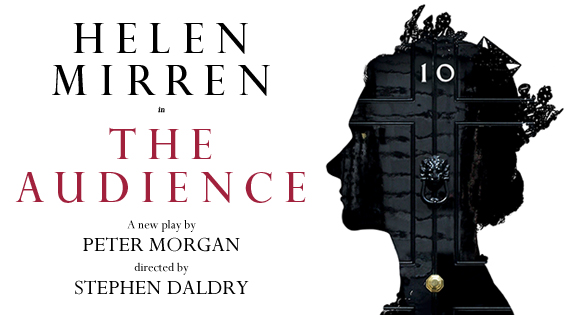While planning my trip to London, I hoped I might be able to catch Dame Judi Dench and Dame Helen Mirren on stage, both of whom were appearing in the West End for limited seasons. I didn’t get to see Dench in John Logan’s Peter and Alice, but I was quite fortunate enough to catch Mirren’s performance in Peter Morgan’s The Audience, an episodic fantasia on the weekly meeting between Queen Elizabeth II and the Prime Minister. These meetings are informal and off the record, giving Morgan much in the way of creative freedom. There have been twelve PMs under the reign of Her Majesty; the play features eight.
The show has been doing extraordinary business, so I was unable to book a ticket prior to my departure, but I thought I’d give “day seats” (the London version of rush) a try. I woke up bright and early on Monday morning and made my way to the Gielgud Theatre around 8:30AM. When I arrived there were already several people in line. The box office opened at 10AM, at which point we were brought into the gorgeous lobby. The box office manager gave us instructions and told us the number of seats that were available, and that after those were sold, they would start selling standing room for the same price. Well, I missed out on getting a seat, but I was not about to pass up the opportunity to see Mirren in one of the hottest shows in London for the princely sum of £10.
The Audience is an affectionate personality piece designed to give Helen Mirren a tour-de-force star vehicle, which she delivers and how. The play itself is somewhat unexceptional; a series of vignettes connected by dialogues between elder Elizabeth and her younger self at various points in her childhood. Morgan’s writing is often sentimental and sometimes veers toward hagiography, but his dialogue is sharp and witty, and makes for great entertainment. Stephen Daldry’s sharp, insightful and intensely focused direction helps to keep the evening fluid and transitions seamless. Chronologically, the play spans the full 60 years of Elizabeth’s reign, but is presented in a non-linear fashion. Part of the fun comes from not knowing which era of Her Majesty’s reign we’re about to visit.
Mirren is utterly astonishing. The actress delivers a staggering performance with stunning mastery and wit. She embodies Her Majesty perfectly, modulating her performance to capture Elizabeth at the various points of her life. The transitions are extraordinary, with some of them happening right on stage in a matter of seconds. And this is not a retread of The Queen, in which Mirren played Her Majesty during the week after Princess Diana’s death in 1997. Through the vignettes, we get a full portrait of a life dedicated to service, and of a person with an unflappable sense of duty, conscience, and compassion. And dry wit. Credit is also due to Bob Crowley for his costumes and Ivana Primorac for her exceptional hair and make-up design.
To my amazement, The Audience has 20 (!) actors onstage, as well as 2 corgis. The eight members of the “Dirty Dozen” are played by some of England’s finest actors. Among these players, Edward Fox makes a strong impression as Churchill in an early scene, and Paul Ritter (Reg in the beloved revival of The Norman Conquests) is a delight as a hapless John Major. Haydn Gwynne offers an amusing, if broad, portrait of the recently deceased Thatcher, who stalks into Buckingham Palace and confronts Her Majesty in a most brusque manner. The scene with David Cameron (Rufus Wright) was the audience favorite, with Mirren bringing down the house by nodding off as the current PM droned on incessantly. However, the most extraordinary support is supplied by Richard McCabe as Harold Wilson, who is rumored to have been the Queen’s favorite of the twelve. McCabe is big, bold and fearless. He’s also warm and funny, but also exceptionally moving in the scene where he tells the Queen of his Alzheimer’s diagnosis and plans to step down.
Plans are underway for a Broadway transfer and audiences in New York (especially fans of Mirren) will lap up The Audience like cat nip. I didn’t know all the Prime Ministers or all of the political events and issues discussed, but that didn’t hinder my enjoyment of the piece. I do understand that some changes are going to be made for American audiences. Tony Blair is not present in the current West End incarnation because Morgan wanted avoid direct comparisons to The Queen, but he is likely to be added for the Broadway production (though I hope Morgan retains all the delightful jokes had at the former Prime Minister’s expense). Also, I understand that the portrayal of Thatcher will be toned down for NY, as Americans tend to have more affection for her than the British. Regardless of what might change, I’ll tell you this: I can’t wait.


